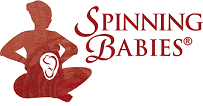Spinning Babies® is a paradigm of physiological release rather than mechanical. In this way, Spinning Babies® extends the concepts of Optimal Fetal Positioning™ (OFP), which was a recent, breakthrough concept in childbirth education. See more in What is Spinning Babies®?
Optimal Fetal Positioning
Childbirth educator Pauline Scott coined the phrase Optimal Fetal Positioning to dehttps://www.spinningbabies.com/wp-content/uploads/2019/10/sample3-1.png the work of Midwife Jean Sutton. These two women published Understanding and Teaching Optimal Fetal Positioning in 1996. Jean Sutton brings to our awareness the importance of mother’s posture and positions in pregnancy, in labor, and also the importance of baby’s engagement into the pelvis at about 38 weeks. Their book includes several tips and bits of birth stories. Why don’t randomized control studies support Optimal Fetal Positioning when midwives and doulas do? Optimal Foetal Positioning was “dumbed down” to mean only the Left Occiput Anterior position. She doesn’t claim there is only one optimal position.
Jean did make the provocative point that birth seems to go easier when baby comes down from the left. This is due to a natural shape (called right obliquity) of the uterus to be rounder on the left and steeper on the right. The effect is that babies from the left are more likely to be curled to aim the crown of the head into the pelvis. The baby from the right may rotate to the posterior in labor due to the steep side extending the back and pointing the top of baby’s head into the pelvis. I agree that this is likely to be true and even if it isn’t always true, it follows enough to be a critical skill for providers to be able to track fetal position and what to help make rotation from either side easier for baby.
Fetal Position Matters
Two facts will help you to understand why fetal position is important:
- Baby’s rotate through the pelvis to emerge from the womb.
- Fetal position affects the relative ease of fetal rotation and descent (including engagement).
Spinning Babies® must not be equated with Optimal Fetal Positioning™. Spinning Babies is a much wider approach. Optimal Fetal Positioning was an important step in the development of childbirth education and in practice.
